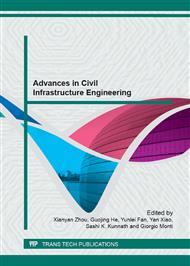p.1051
p.1056
p.1060
p.1069
p.1073
p.1077
p.1083
p.1087
p.1092
Numerical Analysis on Seismic Performance of Beam-Column Joints Strengthened by Top and Seat Angles in the Added-Storey Steel Frame
Abstract:
Based on the ANSYS platform, set up five finite element models of beam-column joints strengthened by top and seat angles, analysis its seismic performance and discuss how the width and thickness of the angle affect it. The results showed that: (1) Strengthened by top and seat angles can effectively reduce the stress of the weld in the column, relocated the plastic hinge, increased the ductility and the energy dissipation capability of the structure. (2) As the width and thickness of the angle increase, the bearing capacity of the joint improved, but its hysteretic behavior and energy dissipation were decreased.
Info:
Periodical:
Pages:
1073-1076
Citation:
Online since:
January 2013
Authors:
Price:
Сopyright:
© 2013 Trans Tech Publications Ltd. All Rights Reserved
Share:
Citation:


